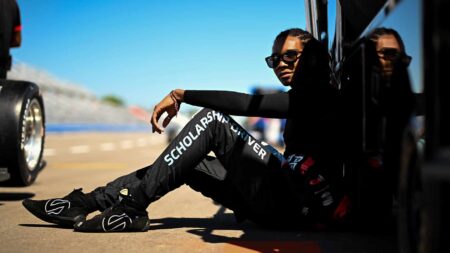
Lundgaard: McLaren can make history with F1/IndyCar double win
Christian Lundgaard is McLaren's new IndyCar star – and wants to make history by helping the team win both in F1 at Bahrain and at Long Beach Stateside on the same day
Twenty-five years ago I wrote a book with Emerson Fittipaldi called The Art of Motor Racing.
It was a how to go racing book featuring Emerson’s discussion about the techniques of driving and the proper approach to the sport. The book included additional chapters with further perspective from Alain Prost, Keke Rosberg, Bobby Rahal, Brian Redman and Al Unser Jr., among others, as well as a foreword by Juan Manuel Fangio.
The book focused on road racing but also included a chapter on oval track techniques and these days it’s clear to me that many Motor Sport readers who have only watched oval racing on television have little or no appreciation of the difficulties of racing on oval tracks. So I thought it might be instructive to sharpen your understanding of this often misunderstood form of the sport by providing a few excerpts from the book about the challenges of racing on ovals.
“In Europe and the rest of the world,” Emerson wrote, “there are two bad images of Indycar racing. The first is that many people think it is just a crazy form of motor racing. They think Indycars just go round and round in circles and that they crash very badly. This image is not correct. Any crash that happens at Indianapolis is for sure a bad crash, and of course big accidents at Indianapolis are shown on television and in newspapers all around the world. But there is much more to Indycar racing than just going in circles and crashing heavily.
“I think most people outside America who haven’t seen many Indycar races are confused about the sport. They don’t know how competitive Indycar racing is nor do they understand how difficult it is to go fast at Indianapolis or any other oval track for that matter.
“The approach and technique for fast ovals is very different than in Formula 1 or road racing in general, starting with the risk. On an oval you cannot make a mistake. If the back end goes into an oversteering slide on an oval, you are in big trouble. In fact, you have little to zero chance to recover.
“To feel the limit of the car or the track on an oval is much harder than on a road course. At the fastest corner in the world in Formula 1 you can slide the back end of the car and you will have a good chance to recover. On an oval that technique just invites trouble.
“Driving a car on an oval looks easy but it is not. When you approach a corner you must turn the steering wheel very carefully. If you have to back off the throttle or use the brakes, you must do so much more carefully and smoothly than on a road course. Everything you do has a much faster reaction because the speeds are so much faster, so you have to minimise that reaction.
“When you turn the wheel on an oval and the front tyres start sliding at the apex of the corner, you are feeling the limit. Once you have got the car to that stage you can then start trimming the wings very carefully so that the car’s balance is more neutral. When you are able to make the car work with just a little bit of understeer you will find your speeds will go up and you will be able to use more power.
“You must get to the point where you are able to go around the corner with full throttle or nearly full throttle with all four wheels sliding in a nice four-wheel drift. To be in control of the situation you must work up to it very slowly and carefully because the things you experience on a high-speed oval are things you won’t experience any other place in the world.
“The first thing I discovered about running in traffic on oval tracks is the respect the other drivers have for the line you are taking. You must respect their line. You cannot go down into a corner at 210-215 mph and chop the other guy. When the guy you are trying to pass is committed to turning into the corner on an oval you cannot try to intimidate him. He has no room for error and neither do you. The result of any attempt at intimidation will be a very bad accident.
“It’s not like a road course where you can usually keep coming down the inside of the other guy all the way to the apex. At the slower speeds of a road course you always have a chance of forcing the guy to back off at the last moment because he has the room and margin for error.
“When you are running in traffic on an oval you must also consider the cars behind you. If someone is very close to your tail, you will feel it. The back end of your car will get very light. Before I drove Indycars I never thought this could happen with a formula car. It is really amazing and it emphasises the fact that you must have your wits about you at all times during an oval race.
“When you race on the short, one-mile oval tracks like Phoenix, Milwaukee and New Hampshire you run very close together – truly wheel-to-wheel. The corners are very long, turning through 180 degrees, and you must be more aggressive and take advantage of every inch of room around you. It is a very tough form of racing because you spend most of your time in a corner and very little time in a straight line. Most of the time you are running in traffic and you must be thinking all the time about how to pass this guy or to protect yourself from being passed by that guy.
“You are lapping at just over twenty seconds each lap and are in traffic most of the time and in a corner most of the time. It’s easy to let your mind, your reflexes and your coordination slow down just a tiny bit and not realise that you have slowed down. To maintain the limit of aggressiveness required on short ovals is extremely tiring mentally, more so than on any other type of race track you will encounter anywhere in the world.”
Emerson had much more to say in the book about racing on ovals. Remember, he was a two-time World Champion as well as a CART IndyCar champion and two-time Indy 500 winner. He knows a thing or two about the sport and I hope these few words will provide some deeper appreciation of oval racing for the uninitiated among you.

Christian Lundgaard is McLaren's new IndyCar star – and wants to make history by helping the team win both in F1 at Bahrain and at Long Beach Stateside on the same day

Louis Foster starts his IndyCar journey this weekend in St Petersburg – can he emulate other British heroes like Nigel Mansell and Dan Wheldon?

Myles Rowe has rocketed through IndyCar's junior ladder with a story like no other – he tells James Elson why this upcoming year is more important than ever

Drive to Survive star Will Buxton has made the jump across the Atlantic to front Fox's new IndyCar coverage – he explained to James Elson why he thinks the championship is the most exciting series out there